French Bulldog Food Aggression: 9 Tips to Treat It Successfully

If you’re dealing with the French bulldog food aggression, then I pretty much know how you’re feeling. That’s why I decided to provide you with some useful tips that helped me with my Frenchie.
Showing food aggression can be quite dangerous especially if you have kids. Kids are curious and they love putting their noses into others’ business. Therefore, this guide is for all those who want to make a good balance between their dogs and kids.
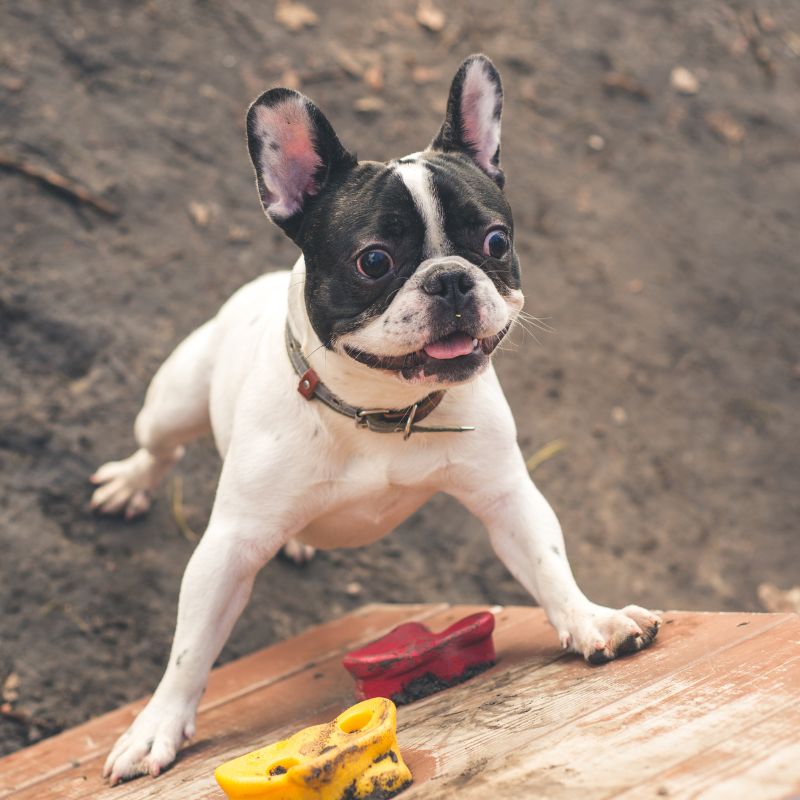
How My Frenchie Showed Food Aggression
I still remember the evening when my Frenchie, Kimi, nearly bit my hand over her food. I had bent down to add a bit more kibble to her bowl, thinking I was being generous. In a split second, Kimi growled and lunged toward my hand, protecting her food. I was shocked and hurt (emotionally more than physically) – how could my sweet French Bulldog suddenly act so aggressive?
After my surprise faded, I realized Kimi wasn’t being “bad” out of nowhere. She was displaying food aggression, also known as resource guarding, a common canine behavior where a dog becomes defensive over food. In this blog post, I’ll share what I learned about French Bulldog food aggression, why you should never interrupt your dog while eating, and how I managed to help Kimi overcome her mealtime aggression.
Understanding Food Aggression in French Bulldogs
Food aggression in dogs is when your pup growls, snaps, or even bites to fend you (or other animals) off from their food. It often stems from a natural instinct to guard valuable resources. In the wild, an animal that protects its food is more likely to survive.
Domesticated dogs like Frenchies might carry some of that instinct. However, that doesn’t mean we should accept it at home.
Resource guarding can range from a low growl or stiffened posture to more serious behaviors like lunging or biting. In Kimi’s case, her warning was a growl that escalated when she thought I was going to take her kibble away.
French Bulldogs, despite their small size and clownish personality, can develop food aggression just like any other breed. Even though they are known as one of the friendliest dog breeds, dogs have instincts hidden in their genes.
In fact, Frenchies love food – many will gobble up meals like there’s no tomorrow. This enthusiasm can sometimes cross into guarding behavior if the dog feels insecure about their food supply.
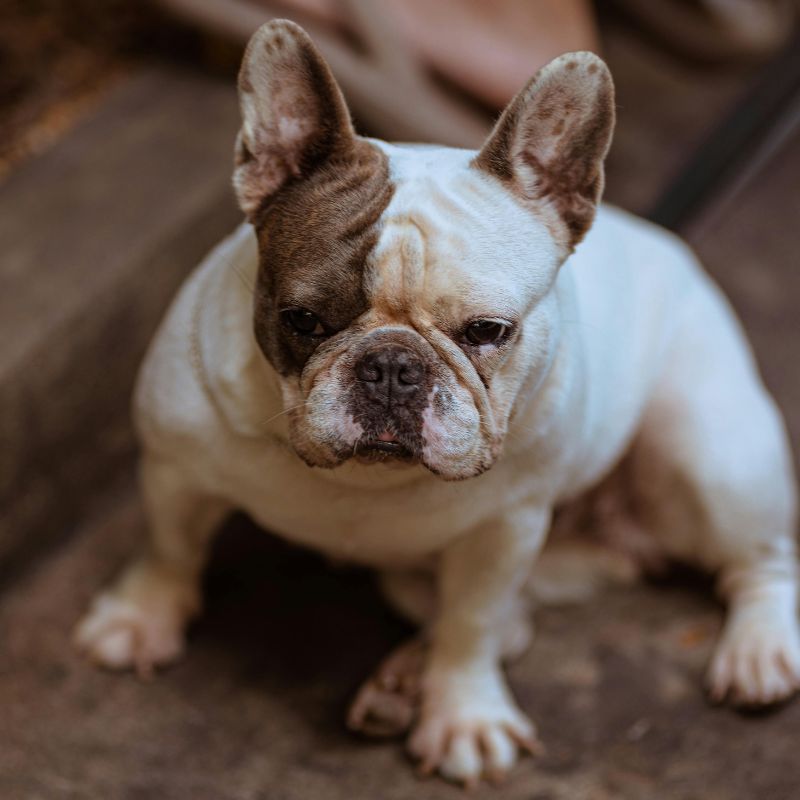
Common Causes of French Bulldog Food Aggression
Causes of food aggression in a Frenchie might include:
- Genetics or Personality: Some dogs are naturally more possessive. While Frenchies aren’t typically known for aggression, individual personality and genetic lines vary.
- Past Experiences: If a dog had to compete for food – such as a runt competing with littermates, or a rescue dog that was underfed – they may have learned to defend food to survive. A Frenchie who came from a tough background or a big litter might be more prone to guarding.
- Anxiety and Insecurity: Dogs that worry about when their next meal is coming can become defensive. If your Frenchie feels anxious that someone will snatch away their bowl, they may preemptively guard it.
- Learned Behavior: Sometimes owners unintentionally encourage food aggression by messing with the dog during meals (more on this below) or by free-feeding irregularly. A Frenchie that isn’t on a consistent feeding schedule might feel they have to protect what food appears.
Signs of food aggression to watch for include growling, showing teeth, a stiffened body, gulping the food rapidly, or freezing when you approach. Some Frenchies, like Kimi, won’t show any sign until that sudden snap. In hindsight, I realized Kimi had been eating very quickly and tensing up at her bowl – subtle signs she was worried about someone interfering.
Why You Shouldn’t Interrupt Your Dog While They’re Eating
One of the most important lessons I learned is: don’t mess with your dog while they eat. There’s old advice floating around that says you should touch your dog’s food or stick your hand in the bowl to “teach them” not to be aggressive.
In reality, this often backfires terribly. Constantly bothering a dog during meals can cause the very aggression you’re trying to prevent. Think of it from your Frenchie’s perspective – how would you feel if someone kept sticking their hands in your dinner? Eventually, you’d get pretty upset and defensive too!
Dogs just want to eat in peace. When we interrupt or harass them during meals, we build frustration and anxiety. The dog learns that humans hovering around their bowl are annoying or even threatening. So, they may develop aggression as a way to say “Back off! Let me eat!”.
Do not disturb puppies
Puppies, in particular, should not be disturbed while eating, because it teaches them early on that someone approaching means their food might be taken away. As the ASPCA and veterinary behaviorists explain, if you repeatedly remove a puppy’s food bowl (even if you give it back), the puppy is essentially learning to guard their food – they never know when it might vanish. Next time, they’ll be prepared to defend it, perhaps by growling or snapping.
I confess, when Kimi was a small puppy I had read somewhere that I should “establish dominance” by touching her bowl or taking it away briefly. I tried it a couple of times – she only looked confused then, but I suspect that practice planted the seed of distrust.
Interrupting a dog’s meal creates food anxiety. Unless you have a very good reason, let your Frenchie eat without interference. In many cases, the simplest management is best: feed your dog in a quiet, safe area and leave them alone until they’re finished. This alone prevents a lot of problems.
That said, it’s wise to teach your Frenchie to be comfortable with people near their food (for safety, especially if you have kids around). However, you must do it in a positive way, not by intimidation. I’ll explain the training steps in the next section. The key takeaway here is: never punish your dog or forcibly grab their food as a “lesson.” Scolding or hitting a dog for growling will only make things worse – they’ll feel even more threatened and escalate their aggression. Instead, we want to show our Frenchies that good things happen when humans are near their food, and that they don’t need to guard it.
Read our blog post on: Why Is My French Bulldog Drinking So Much Water?
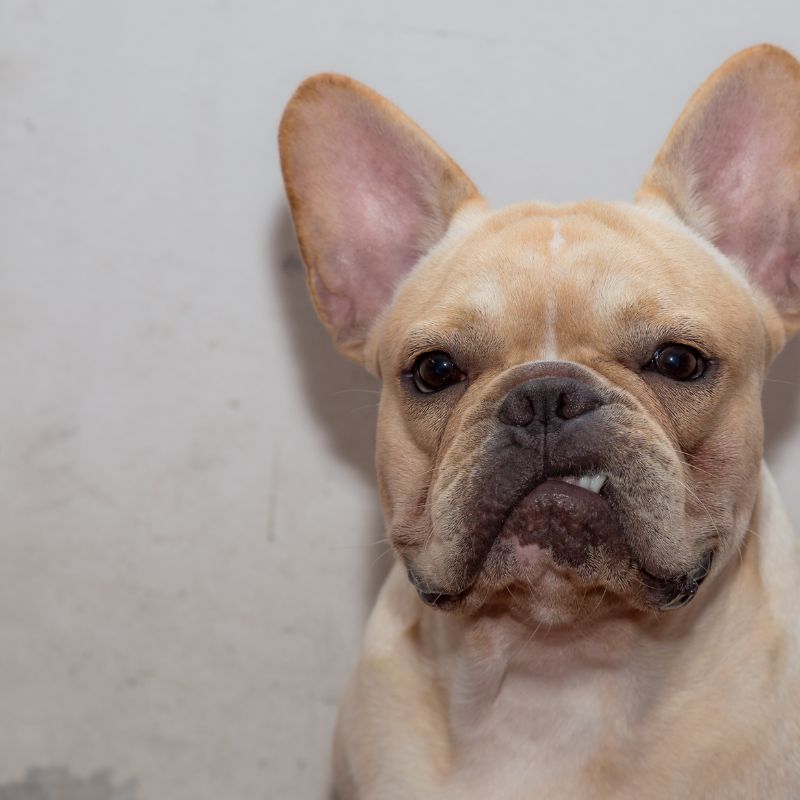
How to Teach Your Frenchie Not to Be Aggressive While Eating
Helping a dog like Kimi overcome food aggression requires patience, consistency, and empathy. The goal is to make your Frenchie feel secure at meal times and to change their emotional response to people near their bowl from negative to positive. Here are some training tips and strategies that worked for me and Kimi, and can help you too:
1. Give Them a Safe Space to Eat
Set up a calm, low-traffic spot for feeding. If your Frenchie currently eats in a busy kitchen, move the bowl to a quieter corner or even another room. Many dogs feel less tense if they know they can eat without anyone (people or other pets) coming close. In multi-dog households, feed dogs separately to remove any competition. I started feeding Kimi in a corner of the living room away from foot traffic. Simply not feeling “crowded” helped her relax a bit.
2. Stick to a Feeding Routine
Dogs, especially Frenchies, thrive on routine. Feed your Frenchie at set times each day (e.g. morning and evening). A predictable schedule can reduce anxiety because your pup learns that food will always come at those times – they don’t have to worry about when or if they’ll eat next. Measure out proper portions appropriate for your Frenchie’s age and size (if you’re unsure, check our French Bulldog growth chart to see how feeding needs change as your Frenchie grows).
A well-fed Frenchie that’s getting the right nutrition is less likely to feel the need to guard food. Also, always ensure fresh water is available in a separate bowl – some dogs get very thirsty after eating, especially on dry kibble. If you notice your dog draining the water bowl frequently, read up on why French Bulldogs drink so much water to rule out any underlying issues. (In general, a calm, satisfied dog with all their needs met will be less prone to stress-related behaviors.)
3. Use Positive Reinforcement
This was the game-changer for Kimi. Instead of taking away her food to “prove a point,” I did the opposite – I added goodies to her bowl. I started by standing a few feet away while she ate, and gently tossed a high-value treat (like a piece of chicken) into her bowl. She was a bit surprised at first, but quickly devoured the bonus treat. I repeated this routine every so often: approach bowl → toss yummy treat → walk away. Kimi began to associate my approach with something positive (extra food!) rather than a threat. Over several days, I gradually stood closer before tossing the treat.
Eventually I could reach right near her bowl, drop in a treat, and she’d look up at me with happy, wagging anticipation instead of tenseness. This “add, don’t take” method is a form of counter-conditioning recommended by many trainers – it teaches the dog that a person coming near doesn’t mean their food will be stolen. It means good news! More treats.
Tip: Always use a treat even better than what’s in the bowl (bits of meat, cheese, etc.), so your Frenchie really loves the reward. And don’t linger or hover. Just drop the treat and casually walk off, to avoid making them nervous.
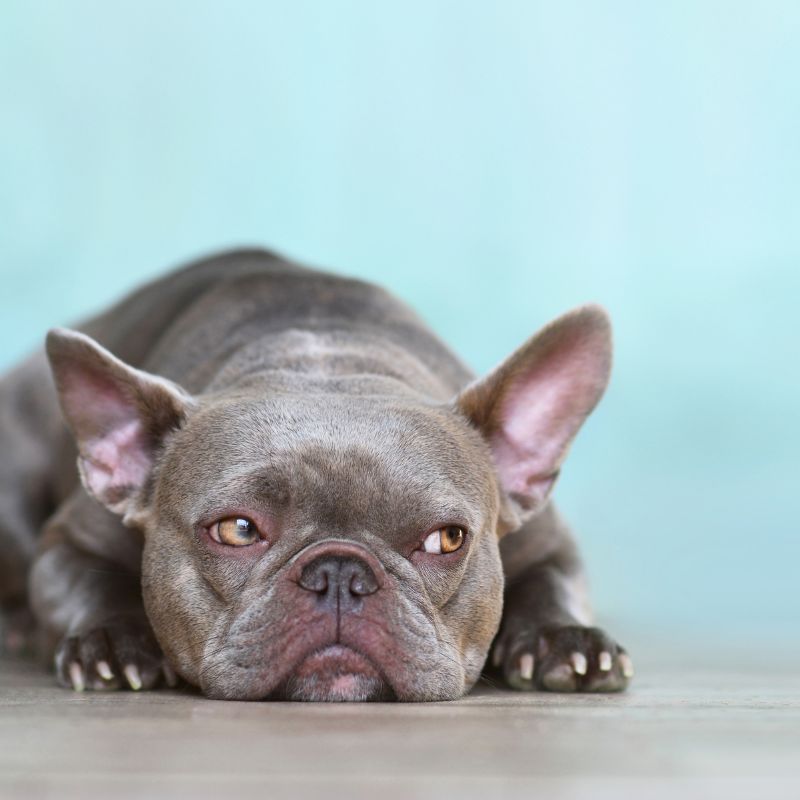
4. Teach a Release Command (Optional)
In Kimi’s case, the treat-tossing was enough to resolve her aggression toward me. But I also worked on a “leave it” and “give” command with other items (toys, bones) to reinforce the idea that surrendering something when I ask leads to rewards.
You can practice by holding a toy or a chew, saying “give” and trading it for a treat. Over time this can generalize to better manners around food. However, never physically pry food out of your Frenchie’s mouth or bowl. If they snatch something dangerous, you may need to, but that’s an emergency. For training, use exchanges and positive methods so the dog willingly lets go.
5. Slow Down Fast Eaters
As mentioned, many French Bulldogs eat at warp speed. Not only is this unhealthy (it can cause choking or bloat), but speed-eating can be a sign of anxiety – a dog wolfing food might be doing so out of fear someone will take it. One great tool I discovered was a slow feeder bowl. These bowls have ridges or maze-like patterns that make dogs work a bit to get their kibble, significantly slowing them down. When I introduced a slow feeder, Kimi’s frantic gulping reduced.

Slower eating kept her calmer and gave me more time to approach with a treat without her feeling so tense. Bonus: slow feeders also prevent digestive issues and gas from Frenchies swallowing too much air while eating. There are many products out there – you can check our guide on the best slow feeder for French Bulldogs to find one that suits your pup. Puzzle feeders or food-dispensing toys serve a similar purpose by turning mealtime into a gentle, engaging activity rather than a race.
6. Stay Calm and Consistent
When dealing with food aggression, your own demeanor matters. Do not yell, smack, or “Alpha roll” your Frenchie for guarding food – those old-school punishments will erode trust and can provoke a serious bite.
Instead, remain composed. If your dog growls, do not punish the growl (that’s your dog communicating discomfort). Just step back and assess what you can change in the environment or your approach. Over a few weeks of consistent positive training, you should see improvement. I know it can be frustrating – I had moments of discouragement too – but consistency truly is key. Little by little, Kimi learned that I wasn’t a threat to her dinner.
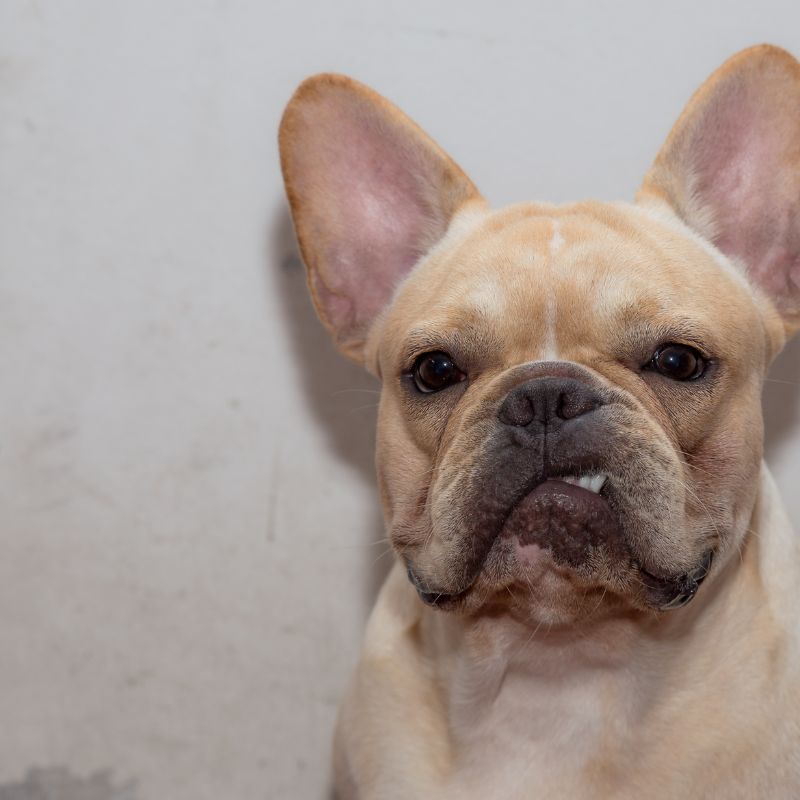
7. Establish Leadership Positively
You are the provider of resources, and your Frenchie should recognize you as the one in charge – but that doesn’t mean using fear. Establish leadership by setting simple rules around feeding: for example, ask your dog to “sit” and wait calmly before you put the food bowl down.
This reinforces that you control the food, but in a polite way. Kimi already knew basic “sit/stay,” so I started making her sit and wait a few seconds before releasing her to eat. This ritual helped reframe the dynamic: the food comes from me, and only when she’s calm. If your Frenchie gets jumpy or demanding, you can even pretend to eat a snack or meal yourself first and feed them after (this mimics the “leader eats first” idea).
Some trainers suggest making a loud noise or saying “No!” if the dog growls, but I found that simply withholding my attention was enough of a correction. (If Kimi showed any guarding posture, I would say “Uh-oh” and step away, ending the treat exercise for that session. She learned that aggressive behavior made the yummy bonuses go away.)
8. Gradual Socialization
If your Frenchie only guards food from other pets or certain people, you’ll need to work on those specific scenarios. For instance, if you have kids, teach your children never to approach the dog’s bowl while the dog is eating.
You can later involve well-supervised older kids in the treat-tossing exercise so your Frenchie generalizes the lesson to all humans. If the aggression is between dogs, feed them separately and only reintroduce eating in the same space once you’ve made progress with each dog individually. Always remove high-value chews if dogs are together to prevent fights.

9. Know When to Get Professional Help
There are cases where food aggression can be deep-rooted or dangerous. If your Frenchie has already bitten you or someone else over food, or if you’re not making progress despite your efforts, consult a professional dog trainer or behaviorist.
Don’t be embarrassed – resource guarding is a common behavioral issue, and experts are there to help. A professional can devise a safe, step-by-step behavior modification plan and guide you through it.
In Kimi’s case, I was lucky that her aggression was manageable with home training. But I was fully prepared to call in a trainer if things didn’t improve. Your safety and your dog’s well-being are our top priority. Working with a pro can make a huge difference, especially with a strong-willed breed like a French Bulldog.
French Bulldog Food Aggression: Wrapping Up
After a few weeks of the above strategies, I noticed big changes in Kimi. Mealtime was no longer a tense showdown. She began to trust that I wasn’t going to steal her food. I could even gently drop a extra kibble into her bowl without so much as a growl – in fact, her little nub tail would wag because she’d expect a treat.
In summary, treating French Bulldog food aggression is about respect and retraining. Respect your dog’s meal, and retrain their associations so they feel secure. With time, your Frenchie will learn that they don’t have to fight for their food.



 French Bulldog Jackets & Coats
French Bulldog Jackets & Coats French Bulldog Dresses & Skirts
French Bulldog Dresses & Skirts French Bulldog Hoodies
French Bulldog Hoodies French Bulldog Sweaters
French Bulldog Sweaters French Bulldog Shirts
French Bulldog Shirts French Bulldog Pajamas
French Bulldog Pajamas French Bulldog Costumes
French Bulldog Costumes French Bulldog Life Jackets
French Bulldog Life Jackets

 French Bulldog Collars
French Bulldog Collars French Bulldog Harness
French Bulldog Harness
 French Bulldog Backpacks
French Bulldog Backpacks







